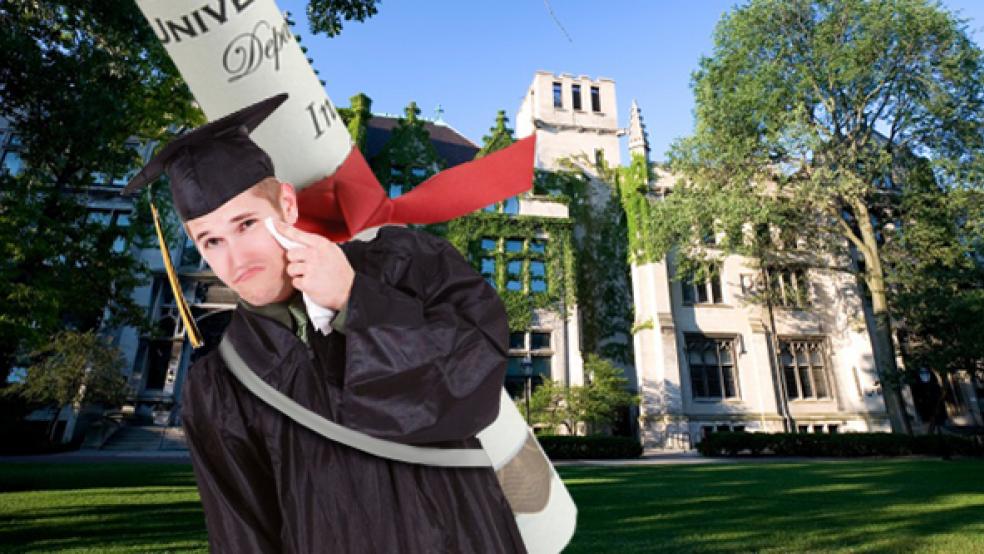Pundits and politicians alike have been arguing about whether or not Congress should prevent rates on subsidized federal student loans from doubling from 3.4 percent to 6.8 percent on July 1. But focusing solely on that rate, which will ultimately have little impact on students’ ability to make their payments after graduation, ignores the bigger issues of soaring tuition and record increases in the amount of financial assistance students are borrowing.
Americans currently owe a record $1.1 trillion in student loan debt—second only to mortgages in household debt, according to the Consumer Financial Protection Bureau.
Federal subsidized loans are capped at $3,500-$5,500 per year, so a student borrowing the maximum amount over five years would only see his or her monthly payments on those loans increase about $40, compared to students who have borrowed at current rates, according to an analysis by Equifax. Sure – over 10 years or repayment, that sum will reach almost $5,000, but that amount needs to be kept in perspective.
“The average student debt at graduation is growing by more than $1,000 a year,” says Lynn O’Shaughnessy, author of The College Solution. “That’s a worrisome number. This rate hike is not.”
Of the 8.8 million students who took out federal student loans last year, just 16 percent took only subsidized federal loans, according to the College Board. By contrast, a whopping 73 percent took both subsidized and unsubsidized loans, which carry a 6.8 percent interest rate. About 10 percent of students use private loans, which have variable rates and tend to be less flexible and more expensive than federal loans.
RELATED: BANKRUPT AT 21: TRAPPED IN A WEB OF STUDENT LOANS
“The reality is if you’re just taking out federal loans, you’re probably not going to get into too much trouble paying the loans back,” says Kal Chany, author of Paying for College Without Going Broke. “It’s when you start looking at additional private loans and wonder if it’s worth borrowing that much extra to go to College A rather than College B … The answer is often ‘no.’”
SOARING COSTS
It’s getting harder and harder for students to afford college without taking on some level of debt. The inflation-adjusted cost of college has more than tripled in the past 20 years at public schools and more than doubled at private schools. Last year, tuition and fees totaled $8,700 for in-state public colleges and $22,000 for private schools, according to the College Board. And that doesn’t include books and other living expenses—often added to a credit card at an 14.9 percent APR.
A full 70 percent of students in the class of 2013 are graduating with debt that averages more than $35,000, according to a report from Fidelity Investments. But for undergraduate students at some private colleges, that amount can double or triple. One in eight borrowers owes more than $50,000.
While some students feel they just have to attend pricey, brand-name colleges, a report released by PayScale in April found that state schools with low tuition offered students the best return on investment, when projected salaries and loans were taken into account.
“When you’re 17, you think this is the most important decision of your life,” Chany says. “The reality is that the decision to go to college is important, but where you go doesn’t matter nearly as much as people think.”
RELATED: HOW GOVERNMENT STUDENT LOANS RUINED COLLEGE EDUCATION
A good rule of thumb for prospective students is not to borrow more to pay for college than their projected first year’s salary. If after grants, scholarships, family assistance, and other aid students need to borrow more than that, the school may be too expensive, says Mark Kantrowitz, publisher of Edvisors Network. That can be tough for arts, psychology and social work majors, who have median annual earnings after graduation of just $30,000.
“If you’re going to a school that doesn’t give a lot of aid, and you need to borrow $50,000 or $60,000 per year, and you’re a liberal arts major [with a low projected income on graduation], you may not be able to afford that school,” Kantrowitz adds.
About 13 percent of students who graduated three years ago are currently in default, and 30 percent of all borrowers are more than 90 days delinquent. But even if a grad can keep up with payments, borrowing beyond one’s limits to afford a dream school could mean other dreams deferred down the road, especially given the dismal job market for young adults. A study last month by the American Institute of CPAs found that among those with student loans, 29 percent have put off buying a house and 15 percent have postponed marriage.
Of those surveyed, 39 percent said they fully understood the burden student loan debt would represent in the future – and 60 percent said they have at least some regret over their choice of education financing.





